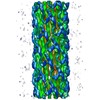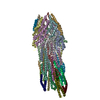+ Open data
Open data
- Basic information
Basic information
| Entry | Database: EMDB / ID: EMD-5352 | |||||||||
|---|---|---|---|---|---|---|---|---|---|---|
| Title | Structure of a type III secretion needle Type three secretion system Type three secretion system | |||||||||
 Map data Map data | This is an reconstruction of the type III secretion needle Type three secretion system Type three secretion system | |||||||||
 Sample Sample |
| |||||||||
 Keywords Keywords |  type III secretion system / needle / helical filament type III secretion system / needle / helical filament | |||||||||
| Function / homology |  Function and homology information Function and homology information type III protein secretion system complex / type III protein secretion system complex /  protein secretion by the type III secretion system / protein secretion by the type III secretion system /  : / : /  cell surface / extracellular region / identical protein binding cell surface / extracellular region / identical protein bindingSimilarity search - Function | |||||||||
| Biological species |   Shigella flexneri (bacteria) Shigella flexneri (bacteria) | |||||||||
| Method | helical reconstruction /  cryo EM / Resolution: 7.7 Å cryo EM / Resolution: 7.7 Å | |||||||||
 Authors Authors | Fujii T / Cheung M / Blanco A / Kato T / Blocker AJ / Namba K | |||||||||
 Citation Citation |  Journal: Proc Natl Acad Sci U S A / Year: 2012 Journal: Proc Natl Acad Sci U S A / Year: 2012Title: Structure of a type III secretion needle at 7-Å resolution provides insights into its assembly and signaling mechanisms. Authors: Takashi Fujii / Martin Cheung / Amandine Blanco / Takayuki Kato / Ariel J Blocker / Keiichi Namba /  Abstract: Type III secretion systems of Gram-negative bacteria form injection devices that deliver effector proteins into eukaryotic cells during infection. They span both bacterial membranes and the ...Type III secretion systems of Gram-negative bacteria form injection devices that deliver effector proteins into eukaryotic cells during infection. They span both bacterial membranes and the extracellular space to connect with the host cell plasma membrane. Their extracellular portion is a needle-like, hollow tube that serves as a secretion conduit for effector proteins. The needle of Shigella flexneri is approximately 50-nm long and 7-nm thick and is made by the helical assembly of one protein, MxiH. We provide a 7-Å resolution 3D image reconstruction of the Shigella needle by electron cryomicroscopy, which resolves α-helices and a β-hairpin that has never been observed in the crystal and solution structures of needle proteins, including MxiH. An atomic model of the needle based on the 3D-density map, in comparison with that of the bacterial-flagellar filament, provides insights into how such a thin tubular structure is stably assembled by intricate intermolecular interactions. The map also illuminates how the needle-length control protein functions as a ruler within the central channel during export of MxiH for assembly at the distal end of the needle, and how the secretion-activation signal may be transduced through a conformational change of the needle upon host-cell contact. | |||||||||
| History |
|
- Structure visualization
Structure visualization
| Movie |
 Movie viewer Movie viewer |
|---|---|
| Structure viewer | EM map:  SurfView SurfView Molmil Molmil Jmol/JSmol Jmol/JSmol |
| Supplemental images |
- Downloads & links
Downloads & links
-EMDB archive
| Map data |  emd_5352.map.gz emd_5352.map.gz | 3.6 MB |  EMDB map data format EMDB map data format | |
|---|---|---|---|---|
| Header (meta data) |  emd-5352-v30.xml emd-5352-v30.xml emd-5352.xml emd-5352.xml | 9.5 KB 9.5 KB | Display Display |  EMDB header EMDB header |
| Images |  emd_5352_1.jpg emd_5352_1.jpg | 61.4 KB | ||
| Archive directory |  http://ftp.pdbj.org/pub/emdb/structures/EMD-5352 http://ftp.pdbj.org/pub/emdb/structures/EMD-5352 ftp://ftp.pdbj.org/pub/emdb/structures/EMD-5352 ftp://ftp.pdbj.org/pub/emdb/structures/EMD-5352 | HTTPS FTP |
-Related structure data
| Related structure data |  2mmeM  3j0rMC M: atomic model generated by this map C: citing same article ( |
|---|---|
| Similar structure data |
- Links
Links
| EMDB pages |  EMDB (EBI/PDBe) / EMDB (EBI/PDBe) /  EMDataResource EMDataResource |
|---|
- Map
Map
| File |  Download / File: emd_5352.map.gz / Format: CCP4 / Size: 3.7 MB / Type: IMAGE STORED AS FLOATING POINT NUMBER (4 BYTES) Download / File: emd_5352.map.gz / Format: CCP4 / Size: 3.7 MB / Type: IMAGE STORED AS FLOATING POINT NUMBER (4 BYTES) | ||||||||||||||||||||||||||||||||||||||||||||||||||||||||||||||||||||
|---|---|---|---|---|---|---|---|---|---|---|---|---|---|---|---|---|---|---|---|---|---|---|---|---|---|---|---|---|---|---|---|---|---|---|---|---|---|---|---|---|---|---|---|---|---|---|---|---|---|---|---|---|---|---|---|---|---|---|---|---|---|---|---|---|---|---|---|---|---|
| Annotation | This is an reconstruction of the type III secretion needle | ||||||||||||||||||||||||||||||||||||||||||||||||||||||||||||||||||||
| Voxel size | X=Y=Z: 1.68 Å | ||||||||||||||||||||||||||||||||||||||||||||||||||||||||||||||||||||
| Density |
| ||||||||||||||||||||||||||||||||||||||||||||||||||||||||||||||||||||
| Symmetry | Space group: 1 | ||||||||||||||||||||||||||||||||||||||||||||||||||||||||||||||||||||
| Details | EMDB XML:
CCP4 map header:
| ||||||||||||||||||||||||||||||||||||||||||||||||||||||||||||||||||||
-Supplemental data
- Sample components
Sample components
-Entire : Shigella needle
| Entire | Name: Shigella needle |
|---|---|
| Components |
|
-Supramolecule #1000: Shigella needle
| Supramolecule | Name: Shigella needle / type: sample / ID: 1000 / Oligomeric state: helical assembly of MxiH / Number unique components: 1 |
|---|
-Macromolecule #1: MxiH
| Macromolecule | Name: MxiH / type: protein_or_peptide / ID: 1 / Name.synonym: MxiH / Recombinant expression: Yes / Database: NCBI |
|---|---|
| Source (natural) | Organism:   Shigella flexneri (bacteria) Shigella flexneri (bacteria) |
-Experimental details
-Structure determination
| Method |  cryo EM cryo EM |
|---|---|
 Processing Processing | helical reconstruction |
| Aggregation state | filament |
- Sample preparation
Sample preparation
| Buffer | pH: 7.4 / Details: 20 mM Tris, pH 7.4, 150 mM NaCl, 2mM MgSO4 |
|---|---|
| Vitrification | Cryogen name: ETHANE / Chamber humidity: 100 % / Instrument: OTHER / Details: Vitrification instrument: Vitrobot / Method: Blot for 3.5 seconds before plunging |
- Electron microscopy
Electron microscopy
| Microscope | JEOL 3200FSC |
|---|---|
| Electron beam | Acceleration voltage: 200 kV / Electron source:  FIELD EMISSION GUN FIELD EMISSION GUN |
| Electron optics | Calibrated magnification: 89285 / Illumination mode: FLOOD BEAM / Imaging mode: BRIGHT FIELD Bright-field microscopy / Cs: 1.6 mm / Nominal defocus max: 2.0 µm / Nominal defocus min: 1.0 µm / Nominal magnification: 50000 Bright-field microscopy / Cs: 1.6 mm / Nominal defocus max: 2.0 µm / Nominal defocus min: 1.0 µm / Nominal magnification: 50000 |
| Specialist optics | Energy filter - Name: JEOL Omega filter / Energy filter - Lower energy threshold: 0.0 eV / Energy filter - Upper energy threshold: 10.0 eV |
| Sample stage | Specimen holder: top entry / Specimen holder model: OTHER |
| Temperature | Min: 50 K / Max: 60 K / Average: 50 K |
| Date | Jul 2, 2008 |
| Image recording | Category: CCD / Film or detector model: TVIPS TEMCAM-F415 (4k x 4k) / Digitization - Sampling interval: 15 µm / Number real images: 330 / Average electron dose: 20 e/Å2 / Bits/pixel: 16 |
- Image processing
Image processing
| CTF correction | Details: CTFFIND3 Each particle |
|---|---|
| Final reconstruction | Applied symmetry - Helical parameters - Δz: 4.30 Å Applied symmetry - Helical parameters - Δ&Phi: 64.06 ° Algorithm: OTHER / Resolution.type: BY AUTHOR / Resolution: 7.7 Å / Resolution method: FSC 0.5 CUT-OFF / Software - Name: SPIDER |
 Movie
Movie Controller
Controller












